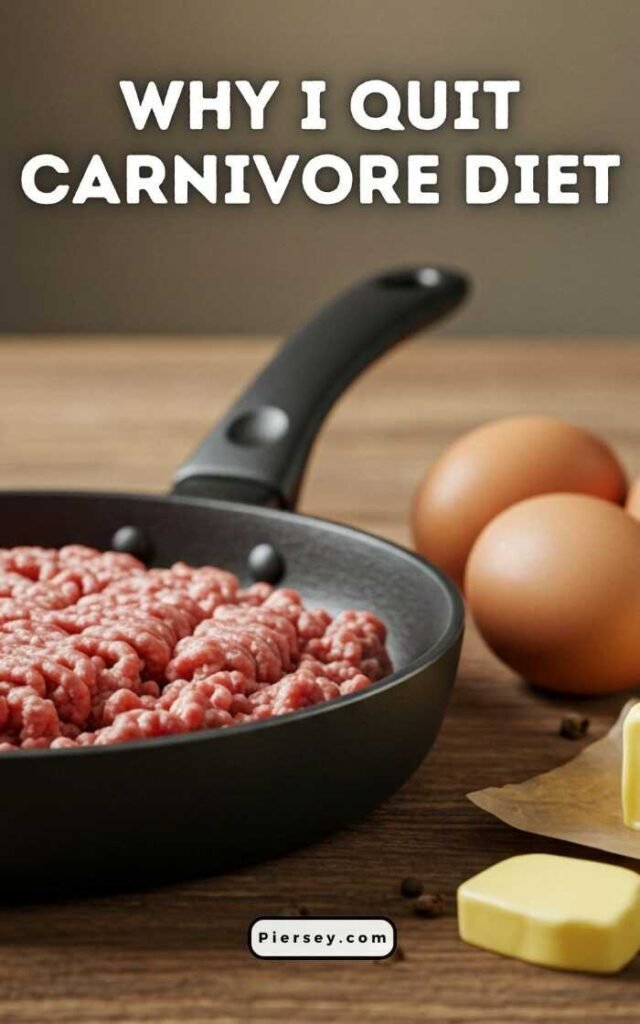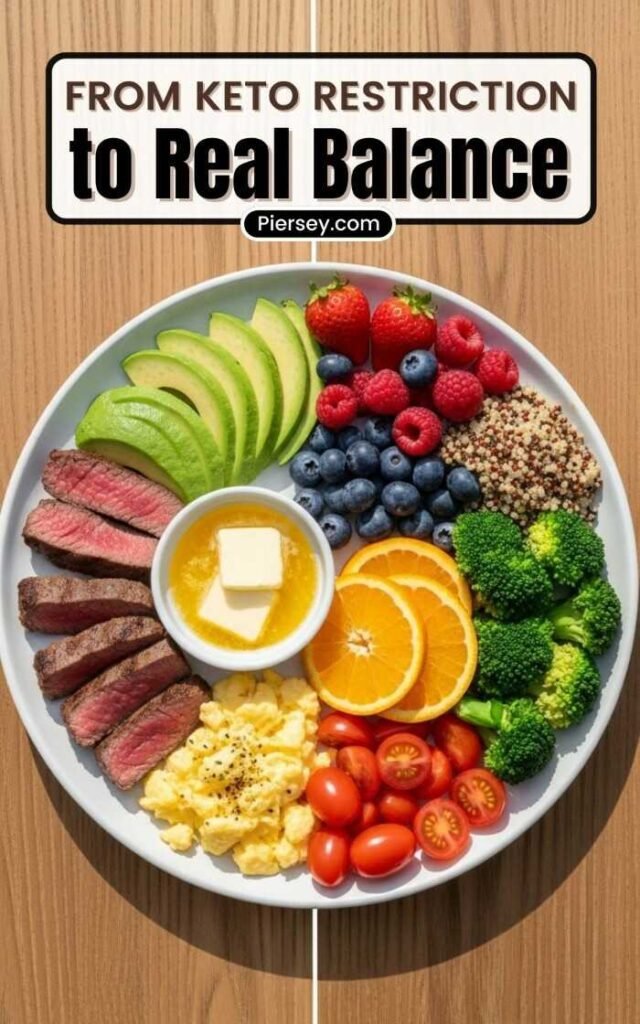If you’ve ever gone all-in on keto or carnivore and thought, “This is it — I’ve finally found the answer!” — I get it. For nearly a decade I lived a low-carb, animal-based life: heavy on beef and lamb, lots of butter, and a routine that felt simple and reliable.
And to be fair — at first, I wasn’t wrong. The results were unreal. I lost weight fast, my focus was razor-sharp, and my energy was through the roof. My mental clarity was the best it had ever been. I felt unstoppable, like I’d finally outsmarted my old food addiction.
But fast forward nine years, and I found myself sitting in my doctor’s office, heavier than I’d ever been, staring at blood results showing high iron, elevated liver enzymes, and eventually… fatty liver disease.
That was my breaking point. After eating an animal-based nutrition plan for so long I realised it was finally time to quit keto and carnivore for good.
If you’re curious how I went from “beef, butter and eggs” to “what the hell happened to my liver,” this one’s for you.
👇 If you just want to watch the full video, I’ve embedded it below 👇
From Food Addiction to Keto Success
Let’s rewind back to before keto — when food absolutely ruled my life. Growing up through my teens and twenties, I had a serious food addiction, especially to carbs and sugar. I’d eat and drink anything without a second thought: McDonald’s, KFC, Pizza Hut, kebabs, pies, beer, cola — basically, if it came in a box or bottle, I was eating it.
Sure, I’d make the occasional healthy choice, but for the most part, my diet was chaos. And it eventually caught up with me. By 2016, I was tired, sluggish, unfit, and dealing with random aches and pains that made me feel decades older than I was.
That’s when I started researching diets online and stumbled across keto — which, at the time, was still pretty underground. It took me a couple of months to get the courage to start, but when I did, the results were instant.
Within weeks, I felt completely different. The weight started melting off, my cravings calmed down, and the mental focus? Out of this world. It was like someone turned on the lights in my brain. I wasn’t even chasing weight loss — I just wanted to feel better — but that part came as a nice bonus.
I was sold. Keto felt like the cure for everything I’d struggled with for years.


When Keto Became My Identity
For the next four years, I lived by the keto rulebook. I kept my carbs around 25–50 grams a day, and it felt easy at first. But then the “keto industry” started exploding. Suddenly, I was making keto bread, low-carb pancakes, fat bombs, and sugar-free desserts with stevia and monk fruit like a full-time baker.
The problem? Even though the ingredients were “keto-approved,” my old habits were still there. I was still chasing the dopamine hit from sweet foods — they just had new labels. I was still addicted, only this time it came wrapped in almond flour and erythritol.
I felt good on the surface, sure. My focus was there, my energy was better than before, and I told myself this was healthy. But deep down, something felt off. I couldn’t shake the sense that I was just managing symptoms instead of fixing the root problem.
Then, around 2018, I started seeing more people online talking about the carnivore diet — eating only meat. At first, I laughed. “No fruit? No veggies? Come on.” But the more I watched videos and heard people claim it cured everything from anxiety to autoimmune issues, the more curious I got.
And let’s be real — I was already eating a ton of meat on keto anyway. So I figured, why not try it?
My Life on the Carnivore Diet
By 2020, I made the jump. I went full carnivore — and at first, it was amazing. My weight dropped again, my energy picked up, and that mental clarity came back. It felt like keto 2.0.
My typical day was simple: two pounds of beef or lamb, cooked in the air fryer, drenched in butter. I even had three kilos of raw butter delivered to my door every month from a local farmer — that’s how deep I was in. If I didn’t eat it all before the next batch arrived, I’d make sure to catch up the following week.
I was strict, too — easily 95% carnivore. The other 5% was the occasional soda, a bit of fruit, or a beer here and there. I wasn’t chasing perfection; I just wanted to feel good.
But over time, that feeling faded. My energy wasn’t as steady. My recovery after workouts slowed down. My sleep started to unravel — and by 2024, it was bad. I was getting maybe three to five hours of sleep a night on average, and even when I did sleep, I woke up exhausted.
At first, I brushed it off as stress or bad sleep hygiene. But my body was clearly trying to tell me something.
When the Warning Signs Started
The real trouble began with a dull pain in my upper right abdomen — just under my ribs. It was faint at first, then became a daily thing. Then ten times a day. Twenty. It was constant.
I finally went to my GP and got bloodwork done. The results hit me like a truck: my iron was sky-high, B12 was through the roof, and liver enzymes were elevated. My doctor could even feel a slight bump when pressing around my liver area, which immediately led to an urgent CT scan.
The scan confirmed it: fatty liver disease.
Nine years of believing I was eating the healthiest diet possible — and my liver was literally struggling to function.
It didn’t make sense at first. I wasn’t eating sugar or processed junk. But looking back, it added up. The constant high intake of red meat, the butter, the excess calories (I was eating 3,000–4,000 a day without realising), and the lack of balance had slowly pushed my body over the edge.
That was my wake-up call.
What I Learned (The Hard Way)
Here’s what that experience taught me: no matter how popular or “scientifically backed” a diet seems, it doesn’t mean it’s the right fit for you forever.
Our bodies change. What works in one season of life can fail you in the next.
For me, years of high-fat, high-meat eating had caused iron overload and liver damage.
In the summer of 2025 my GP and a consultant advised I cut all red meat from my diet because my body had iron overload. Heme iron from beef and lamb was the last thing I needed. I’m working with NHS doctors and a consultant to bring my blood levels down, and they mentioned options like iron chelation as a possibility — but first the obvious step was dietary change.
Waiting for tests and appointments on the NHS can take time, so I’ve been careful and honest with my doctors and following their guidance. It’s been humbling: nine years of a diet I trusted, and now I’m being told it needs to stop — at least until my bloods are safe.
Since then, I’ve completely flipped the script. I’ve switched to a high-carb, low-fat, plant-focused way of eating, and the difference has been night and day. My energy is better, my sleep is returning to normal, and for the first time in years, I feel like my body is actually healing instead of just surviving.
I’ve also set myself a new goal: to lose 100 pounds in a way that supports my health — not destroys it.


Final Thoughts: Why I Had to Let Go
Walking away from keto and carnivore after nine years wasn’t easy. Those diets gave me structure, discipline, and confidence when I needed them most. But eventually, they took more than they gave.
What I’ve learned is this: sometimes the diet that once saved you becomes the one holding you back. The signs were there — the fatigue, the insomnia, the liver pain — but I ignored them because I didn’t want to admit it wasn’t working anymore.
If you’re feeling stuck or unwell on a diet you once loved, don’t be afraid to question it. Listening to your body doesn’t make you weak — it makes you smart.
These days, I’m focusing on foods that actually make me feel alive again. More plants, more carbs, less stress. The complete opposite of what I used to preach.
If you’ve been through something similar — whether it’s quitting keto, struggling with food addiction, or just feeling confused about what “healthy” even means anymore — share it in the comments below. Your story might help someone else going through the same thing.
And if you prefer video, you can find me on YouTube where I share my full experience, new diet approach, and my ongoing journey to reverse fatty liver and lose 100 pounds — the healthy way.


